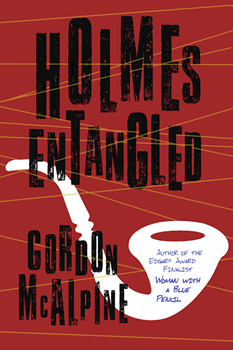

Holmes Entangled by Gordon McAlpine
From the Edgar-nominated author of Hammett Unwritten and Woman with a Blue Pencil comes a startling meta-fiction tale told in the voice of Sherlock Holmes. Set in 1920s’ London, Cambridge, and Paris, HOLMES ENTANGLED by Gordon McAlpine leads the infamous sleuth on an adventure through labyrinths of crime and espionage in a mortally dangerous inquiry into the unseen nature of existence itself.
Sherlock Holmes, retired from investigations and disguised as a professor at Cambridge, is shaken when a modestly successful author named Arthur Conan Doyle calls upon him at the university. This Conan Doyle, notable for historical adventure and science fiction stories (but no detective tales), somehow knows the false professor’s true identity, and pleads for investigative assistance. Someone is trying to kill him.
Intrigued by how the “middling scribbler” ascertained Holmes’s identity in the first place, despite the detective’s perfect disguise, Holmes agrees to investigate.
With the assistance of Dr. Watson’s widow, Holmes persists, exploring séances, the esoterica of Edgar Allan Poe, the revolutionary new science of quantum mechanics, and his own long-denied sense of loss and solitude. Ultimately, however, even Sherlock Holmes is unprepared for what the evidence suggests.
At first glance, this story may seem like fan fiction, but HOLMES ENTANGLED can more aptly be described as a mash-up of meta-mystery with meta-biography.
I caught up with McAlpine and asked him about his take on meta-fiction. He said that he chooses to avoid purely academic definitions and feels most comfortable discussing meta-fiction in the manner he assumes some readers and critics assign the term to his work.
HOLMES ENTANGLED, for example, “may be called meta-fictional because the novel assumes a reader’s previous familiarity with the character of Sherlock Holmes and plays on that familiarity by presenting Holmes in a new light. This may introduce fundamental questions regarding the plasticity of character, cultural collaboration of authorship, and the inextricable relationship between the narration of events and the events themselves.”
These meta-fictional elements are heightened by a character named Arthur Conan Doyle. Doyle, of course, is famous as Holmes’s creator, but he does not carry that role or distinction in this novel.
“Holmes’s author requests the help of his own fictional creation, an anomaly apparent only to the reader and not to any of the characters,” McAlpine says.
Framed in the consistent reality of its world—rather than ours—the story moves forward in a dramatic, coherent, and suspenseful manner.
“It is a novel of ideas, some of which may be derived or deepened by a meta-fictional reading, but it is also, most importantly, a human story of friendship, loss, and identity…oh yes, and crime,” McAlpine says.
HOLMES ENTANGLED focuses on Holmes, Doyle, and Poe—and while some would say these characters and authors are over-exposed, McAlpine has achieved a fresh narrative.
I asked the author why he was drawn to these larger-than-life literary/historical characters, and he admits to being intrigued by the disparate characteristics and achievements for which each is well known. Beyond that, he finds himself also intrigued by the ways these semi-mythical figures are not larger than life: “That is, their flawed, ordinary humanity in extraordinary circumstances,” he says.
When used in a work of fiction, well-known characters provide immediate cultural familiarity and context, which, in turn, “provides an author the opportunity to fulfill, deny, or alter said expectations in ways that comment on both the cultural figure and our perceptions of him, all the while serving the larger purpose of whatever story I’m setting out to tell,” he adds.
McAlpine notes that his initial inspiration for HOLMES ENTANGLED evolved from a skeletal concept: An author walks into a room to seek the help of one of his own characters, each being equally real and wholly unaware of their literary relationship.
Building on that concept, McAlpine could have invented two new characters, an author and his fictional creation, but he would then have needed extensive back story and world building to achieve the same effect. As McAlpine points out, “The seemingly metaphysical context is immediately and economically apparent.”
The novel can proceed with the story line rather than addressing the “celebrity” quality of the characters.
Intrigued, I asked McAlpine how he saw the underlying theme of the story.
“I think of Hammett Unwritten as being about midlife malaise and the ephemeral nature of creativity… HOLMES ENTANGLED about what happens when the sympathetic ‘witness’ to one’s life is lost and how loss can open us to heretofore ‘unbelievable’ ideas.”
In perhaps a masterful “what if,” McAlpine’s stories explore the unseen nature of existence and the idea of a parallel universe—or universes. He notes contemporary science suggests such wonders may actually exist. Long before he read about quantum uncertainty, he read fiction. To McAlpine, fiction creates an alternate universe.
“After all, isn’t even the most realistic story, grounded in strict historicity, set in a time and place that never truly existed except in the minds of writer and readers, none of whom was ever a physical part of that universe?” he says.
HOLMES ENTANGLED seems to continue the question raised in Hammett Unwritten: what is the nature of fiction and those who create it? Given that, I asked McAlpine how he saw the fluidity of the creative process. He says he sees no clear separation between the telling of a story and the “actual” story. Referring again to the quantum world, he notes, “there is no reality without an observer.”
To McAlpine, while a good story consists of characters, conflict, and action, it also requires the ever-unseen character, the author. “Sometimes, layers of seeming autobiography suggest the author is as visible on the page as any…fictional characters. But this is always illusion. Even when an author sets out to put his or her ‘true’ self on the page, what results is, at best, a fascinating simulacrum.”
In McAlpine’s view, the author is the one essential character who always remains a mystery. He is intrigued by the author’s unseen presence. “The teller and the told and the place where the line between them blurs. I am enticed, even if the only way to approach such a place is by creating yet another story, itself replete with further mystery.”
McAlpine is currently creating that story. Set in 1914, a crusading psychoanalyst, personally acquainted with both Freud and Jung, leaves her home and practice in Greenwich Village for the plains of Kansas to examine a young patient incarcerated in a psychiatric hospital for the criminally insane. “Much darkness ensues. Light as well,” he says.
We’ll have to wait for the rest.
*****
 Gordon McAlpine is the author of Woman with a Blue Pencil and Hammett Unwritten and numerous other novels, as well as a middle-grade trilogy, The Misadventures of Edgar and Allan Poe. Additionally, he is coauthor of the nonfiction book The Way of Baseball, Finding Stillness at 95 MPH. He has taught creative writing and literature at U.C. Irvine, U.C.L.A., and Chapman University. He lives with his wife Julie in Southern California.
Gordon McAlpine is the author of Woman with a Blue Pencil and Hammett Unwritten and numerous other novels, as well as a middle-grade trilogy, The Misadventures of Edgar and Allan Poe. Additionally, he is coauthor of the nonfiction book The Way of Baseball, Finding Stillness at 95 MPH. He has taught creative writing and literature at U.C. Irvine, U.C.L.A., and Chapman University. He lives with his wife Julie in Southern California.
- The Suspects by Joan Havelange - September 30, 2021
- Unknown Threat by Lynn H. Blackburn - February 28, 2021
- The Magdalene Reliquary by Gary McAvoy - December 31, 2020

